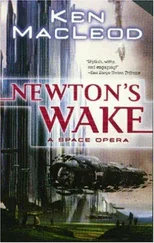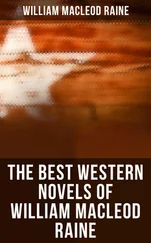Darvin drained his dubious cup. “That,” he said, “is the wildest speculation I have heard today. It makes Orro’s intelligent mechanical flitters seem like a sound and sober possibility. That’s why I think you’re right, Kwarive.”
“You do?”
“Well, it’s that or something wilder. We must take this to the project.”
A few days later an airship of Seloh’s Flight flew slowly over Five Ravines. Adults spared it a glance, and gained from that glance a touch of reassurance. Gangs of kits tried and failed to reach its altitude. After crisscrossing the town a few times it flew away to the north. The following day, here and there about town, men with the municipal crest on the buckles of their crossed straps were observed, or rather, not noticed, flying into certain trees, sawing off the branches they perched on, and flying away. That evening, a telegraph machine rattled in Darvin’s office, and spat forth a message that, when decoded, read: FRUIT ON SCHED PREP DESP URGENT.
The device was like an enormous flechette or flighted crossbolt, several wingspans long. With its backswept wings — or stabilisers, as the techs insisted on calling them — it resembled a crude copy of the alien flying machine in the photograph. Pointed at one end, open at the other; rivets making small elliptical shadows on its burnished steel plates. It lay atop a trolley on a railed wooden ramp with an upward slope. Heavy electrical cables trailed from the ramp. Somebody counted backward. At zero, flames sputtered from the open end, then roared forth like an opened furnace door. The device rushed forward and hurtled into a shallow ascent of several eight-eights of wingspans on the horizontal and about two eights on the vertical, then tilted downward, hit the desert, performed a couple of spectacular cartwheels, and exploded with a deafening bang.
Ears still ringing, Darvin heard a cheer from the small crowd of project members who, with him, watched at a supposedly safe distance.
“Impressive, isn’t it?” said Nollam, the young telekinematography technician.
“You could say that,” said Darvin. “Also expensive, futile, and dangerous.”
“All of these,” said Nollam. He rubbed his hands and shook out his wings. “This is our top-secret self-propelled giant flechette project. Officially called Project Crossbolt. And us lowly types have been officially told to unofficially call it Project Piss-Crystal.”
“Saltpetre?”
“Yes,” said Nollam.
“Why?”
“In case any news of it leaks out.”
“I should have thought,” said Darvin, strolling back to the huts of the project’s desert camp, “that naming it after the device’s shape and after a component of bomb powder rather gave the show away.”
He stopped. “Oh,” he said. “I see.”
“You do,” said Nollam. “Gives great cover. The Gevorkians must know we’re up to something up here, and that’s just the sort of rind to throw to them. Besides,” he added, “it might just work.”
Orro, who had watched the display from the air, swooped to land beside them.
“Wonderful!” he said. “I must tell you, this is substantially better than what I know of such work in Gevork.”
“That’s a relief,” said Nollam.
“Of course my knowledge is years out of date,” said Orro, sounding worried. He brightened, and clutched the technician’s arm.
“Has anyone thought of launching the device straight upward?”
“Firing it at the sky?” said Nollam. “Whatever for?”
“It could be a method of reaching extreme altitudes.”
“I’ll pass it on,” said Nollam. He didn’t sound as if he meant it.
“Seriously,” said Orro. “It’s important.”
“All right, man, all right.”
The ground was hard. Their breaths puffed in front of them. The tips of Darvin’s ears, toes, and fingers ached. He still preferred the pale clear blue of the desert winter midmorning sky to the dripping clouds and fogs of the warmer and moister coast.
Kwarive, now seconded to the project since her biological discovery, had chosen to watch from the still safer distance of the camp. She met them at the gate. “It’s a good start,” she said. “But I don’t see it ever reaching the sky.”
“It doesn’t have to,” said Nollam. “It just has to reach a Gevorkian gasbag.”
Kwarive, Darvin gathered, was not to be told of the misdirection.
“How horrible!” she said. “I’m glad my — our part of the project isn’t so destructive.”
Her, or their, part of the project now dominated the barracks square, though to a casual observer, the transplanted tree by the lecture ring might merely have been there to provide a pleasant sight of home. The blimp, moored eight-eights wingspans above it and trailing cables, might have been a lookout over the flat dry plain. The grazer dung from the prey paddock heaped around the tree’s foot might have been to fertilise the barren soil in which this coastal tree improbably grew. A hardy evergreen, its lean spire and parabolic array of branches and leaves seemed almost to yearn for the sun. Instead, as Nollam’s telekinematographic reception apparatus cabled to a big wire frame in the tethered blimp monitored, the tree — or rather, the fine network of unknown alloy that permeated it from the roots up — was sending a continuous stream of incomprehensible etheric information skyward. None of Nollam’s equipment could make more of it than a flickering screen of snow.
Eights upon eights of electric shittles burrowed in the dung, and now and then poked their unblinking eyes out upon the world. No attempt to attract their attention — whether with bright-lit pictures, earnest discourses, or people jumping up and down — had elicited the slightest response. Kwarive had observed and recorded the insects’ reactions over two days and nights, and the best statistical methods she could apply showed that their gazes, as much as the radio waves which they continued to pulse forth, were random. They bore no relation to the putative objects of interest presented to them. At any given time there would be a few shittles peering outward, but that was what shittles did.
What the scientists working on the other aspects of the project made of all this bizzare activity Darvin, Orro, and Kwarive occasionally speculated on, but took care not to ask. Knowledge within the project was as compartmentalised as an insect’s body.
“I’m going to try something new today,” Kwarive said, stopping beside the wheeled screens that surrounded the base of the tree.
“What is it this time?” Nollam asked. “Obscene photographs? Religious texts? A careful heaping of stones in eights, to show them how we count?”
“No,” said Kwarive, in a tone that suggested she might have considered these. “Maps.”
“Isn’t that a security risk?” asked Darvin.
“Oh yes,” said Kwarive. “I’ve cleared it with Markhan.”
Orro and Darvin looked at each other and shook their heads. Neither of them had so much as spoken to the chief scientist since the project began.
“We’ll leave you to it,” said Darvin. “Good luck.”
“Bring me some tea,” said Kwarive, spreading a large sheet of paper on the frosty ground and kneeling beside it with ink bottle and brush. “Hot and soon.”
The three men made their way to one of the barrack roosts. Its sleeping racks empty by day, its interior space had been turned into a long laboratory. Cluttered tables filled the aisle. Between them snaked dangerous trailing cables that originated in the blimp and ended around the back of the cable-festooned mass of the telekinematographic receiver. This device was a wooden cabinet the size of a meat cupboard with a glass screen like a window, a couple of handspans wide, in the front near the top. The glass looked thick and somewhat convex, with rounded corners. At the moment it displayed a random flicker of spots and lines that hurt the eye if you watched too long. Nollam joined the technicians trying to make sense of the tree’s data stream, Orro studied the results of the latest aeronautical experiments — the real ones, being carried out far away at a place unknown — and Darvin headed down an aisle to the tea urn. He took tea out to Kwarive, who had already completed an impressive sketch-map of the Selohic coast. Just as he arrived she added, in the empty middle of the map, a stylised, chevron-winged flechette.
Читать дальше












